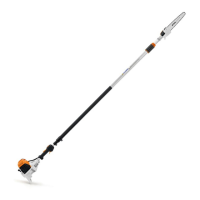HT 102, HT 103, HT 132, HT 133
English
9
Place your left hand on the shaft and
your right hand on rear grip and throttle
trigger. Left-handers must follow these
instructions, too. Keep your hands in this
position to help maintain control of your
pole pruner while working at all times.
WARNING
Never attempt to operate your power
tool with one hand. Loss of control of the
power tool resulting in serious or fatal
injury may result.
WARNING
In order to properly control your pole
pruner, always maintain good balance
and a firm foothold. Never work on a
ladder, in a tree or on any other insecure
support. Never hold the machine above
shoulder height. Do not overreach.
When working at a height above 15 feet
(4.5 m) use a lift bucket. For pole pruner
with adjustable shaft, expand the shaft
only as far as necessary for the intended
application.
WARNING
Special care must be taken in slippery
conditions (wet ground, snow) and in
difficult, overgrown terrain. Watch for
hidden obstacles such as tree stumps,
roots, rocks, holes and ditches to avoid
stumbling. For better footing, clear away
fallen branches, scrub and cuttings. Be
extremely cautious when working on
slopes or uneven ground.
WARNING
Take extreme care in wet and freezing
weather (rain, snow, ice). Put off the
work when the weather is windy, stormy
or rainfall is heavy.
Working Conditions
Operate and start your power tool only
outdoors in a well-ventilated area.
Operate it under good visibility and
daylight conditions only. Work carefully.
WARNING
WARNING
Inhalation of certain dusts, especially
organic dusts such as mold or pollen,
can cause susceptible persons to have
an allergic or asthmatic reaction.
As soon as the engine is
running, this machine
generates toxic exhaust
fumes containing chemi-
cals, such as unburned
hydrocarbons (including
benzene) and carbon
monoxide, that are
known to cause respira-
tory problems, cancer,
birth defects, or other
reproductive harm and
other injuries. Some of
the gases (e. g. carbon
monoxide) may be color-
less and odorless and
can cause asphyxiation
or death very quickly. To
reduce the risk of serious
or fatal injury/illness from
inhaling toxic fumes,
never run the machine
indoors or in poorly venti-
lated locations. If exhaust
fumes become concen-
trated due to insufficient
ventilation, clear obstruc-
tions from work area to
permit proper ventilation
before proceeding and /
or take frequent breaks to
allow fumes to dissipate
before they become
concentrated.

